
August 2022
Introduction by Scott Gordon
Our next speaker is Lynne Wilson. Lynne Hilton Wilson earned her PhD in theology and American Religious History from Marquette University. Her doctoral dissertation compared Joseph Smith’s understanding of the spirit with his contemporaries. Her master’s degree focused on New Testament studies.
Lynne attended BYU as an undergraduate, where she studied nursing and music. She returned to BYU as an adjunct professor of religion and to teach at Education Week.
She presents regularly at the Mormon History Association, Society of biblical literature, and the like. Lynne also served in the church education system for the past 35 years. Currently, she teaches Institute and there’s more there (in the program) you can read about her.
Her husband is Elder Dow Wilson, they live in Palo Alto have seven children, all with red hair. So, I like them very much for that! Eight grandchildren: blonde, ginger and brown (hair).
With that, I’ll turn the time over to Lynne Wilson.
Presentation by Lynne Hilton Wilson

Restoring a kingdom of priests and priestesses fits very nicely into the new name of “FAIR” or faithful answers, informed response. However, I chose the name when I thought it was the old FAIR – which was, of course, the original Foundation for Apologetic Information and Research.
Defending Prophetic Statements about Women
I would like to defend today two prophetic statements about women.
First of all, our beloved Russell M. Nelson, “How I yearn for you to understand that the restoration of the priesthood is just as relevant to you as women as it is to any man. Because the Melchizedek priesthood has been restored, both covenant keeping women and men have access to all the spiritual blessings in the church.”[1] That’s from General Conference 2019.
The next statement is by our Prophet Joseph Smith, and this is his first meeting at the Relief Society on March 17, 1842. “I have desired to organize the sisters in the order of the priesthood, I now have the keys by which to do it.”[2] And then just a week after this, the prophet continued and said, he’s just elaborated at another Relief Society meeting. “The Lord is going to make the Church of Jesus Christ, a kingdom of priests, a holy people, a chosen generation, as in Enoch’s day, having all the gifts of the Spirit,” and he goes on and on and on.
The Focus of the Restoration
So, my topic of restoring priests and priestesses of the restoration. I don’t I don’t want to sound too ostentatious here. But the more I thought about it, the more I realized: this is really the whole focus of the restoration. Just look how things came to pass in the restoration.

We start out with the first vision, and then we go to the spiritual opening of the cannon and bringing up the Book of Mormon, the gift of the Holy Ghost, which is applying the atonement and sanctification. We start gathering Israel with the priesthood ordinances, we establish Zion and the holy temples and peoples — all to prepare a kingdom of priests and priestesses to receive their exaltation. So, I really feel like everything that has come to pass and the restoration has this as the end goal.
Three Basic Points
I’ve divided my presentation into three basic points: (first) a historical perspective on the priesthood, and I’ll go all the way from the Bible clear down to Joseph’s scripture and sermons. And then secondly, the purpose of the Relief Society for future priestesses. And third, the purpose of the temple to prepare a kingdom of priests and priestesses.
A Historical Perspective on the Priesthood
Biblically, we know that Aaron and his sons and his cousins were all ordained and washed and clothed in garments for the priesthood. Exodus 40 reads, “thou shalt anoint them, that they may minister unto Me in the priest’s office, for their anointing shall surely be an everlasting priesthood throughout their generations.”
As the priests begin their work from the tabernacle, they’re moved into the first temple, and then the second temple, and then Herod reforms that second temple, and the priesthood becomes the foundational structure of Temple ritual.
But in the New Testament, the priesthood takes on a new light. Rather than functioning just in the temple, the priesthood is given to those who are not of the Aaronic order. In fact, 1 Peter 2:5&9 reads, “Ye are building up a spiritual house, an holy priesthood, to offer a spiritual sacrifice acceptable to God by Jesus Christ. Ye are a chosen generation, a royal priesthood, a holy nation and a peculiar people.”
After the apostolic tenure, and our early church fathers are grown, Turtullian, and many others refer to the Christians as all priests. However, by the time of the 16th century, one of the complaints that Martin Luther was most concerned about in his 95 theses and afterwards is that the priesthood had become corrupt, and he sought for a priesthood of all believers.
Anti-Priesthood
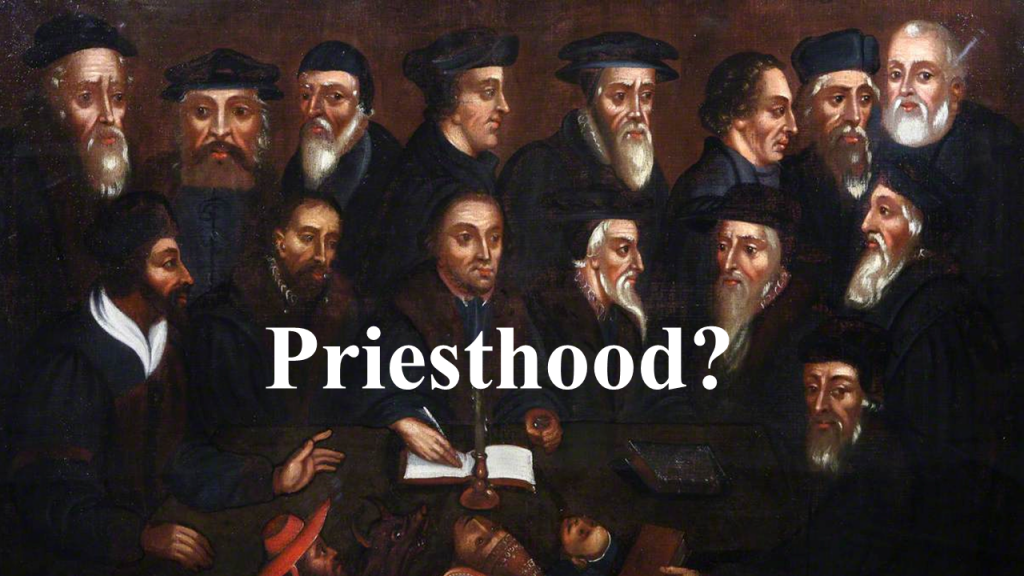
So as the Reformation began to unfold with Calvin and Zwingli, and others, this question of the priesthood became very important. And unfortunately, it became a point of contention, and they began attacking the priesthood. In fact, Protestants usually used the word priesthood as anti-authority – they weren’t in favor of it at all. In fact, they called it “popish,” another word for the Roman leader of the church.
This also reflected in United States and in 1824, we find documents like “we distinctly know that the popish priests only seek for power, that they may enjoy it against our principles.” Now, probably the most famous theologian of the day, at least in the 19th century, was Charles Hodge. And he was so against this that he even equated the pope with the Antichrist. He – papacy is the name for the Holy See or the Pope, (you see, when you go to school with the Catholics, with your doctorate, you learn all these good words like papacy, you know).
When we look, though, at Richard Bushman’s analysis of Joseph’s environment, he said “the priesthood was an alien concept to Yankee Christians. Joseph may have considered it prudent to say nothing about the priesthood in his early years or possibly he didn’t understand it himself.” Did he understand it? When did Joseph learn about this? I’m fascinated.
When and How Was the Priesthood Restored
I would like to take you on a short little journey as we go through this historical outline, to look at when it was restored and how it was restored. September 21, 1823, Moroni – first visit – mentions the priesthood. As we know, “Behold, I will reveal unto you the priesthood by the hand of Elijah the prophet, before the coming of the great and dreadful day of the Lord.”
Continuing on in 1829, as the Blitzkrieg of the Book of Mormon translation begins under Oliver Cowdery’s turkey quill, he translates over a hundred References — hundreds, not just over 100 — hundreds of references that refer to the priesthood in that great text – 1829.
The Book of Mormon Taught Joseph About the Priesthood
I find the Book of Mormon is what taught Joseph about the priesthood, I do not think it evolved as it went. And I’d like to give you just a few examples. Remember, when Oliver sits down, they start in Mosiah. So, Alma was quite soon after the translating began.
Look at Alma, chapter 13. And this is not talking about the lower priesthood, the Aaronic which was in the biblical tents, this is the higher priesthood. “Thus being called by this holy calling, and ordained by the high priesthood of the Holy Order of God, to teach his commandments unto the children of men, that they might also enter into his rest. And the high priesthood being under the order of the Son, which order is after the foundation of the world.”
And he just keeps going and going and going, you know. This is saturated with references to both priesthoods, but mainly the higher priesthood – because the Book of Mormon people did not stem from Aaron. We know they’re Josephites, and they’re Mulekites. The Mulikites, of course, are from Zedekiah. They’re from Judah. So, the high priesthood is what Nephi and the following prophets were given by the Lord in their prophetic mantle.
Joseph and Oliver, I think, learned to ask the questions about priesthood when they got to 3 Nephi 18:37, “the disciples bare record that he gave them power to give the Holy Ghost.” Now if Jack (John W. Welch) were here, he’d stand up and say, “this is one of many verses that may have stimulated Oliver and Joseph,” but this is the one that I got from Jack that he thinks is the best.
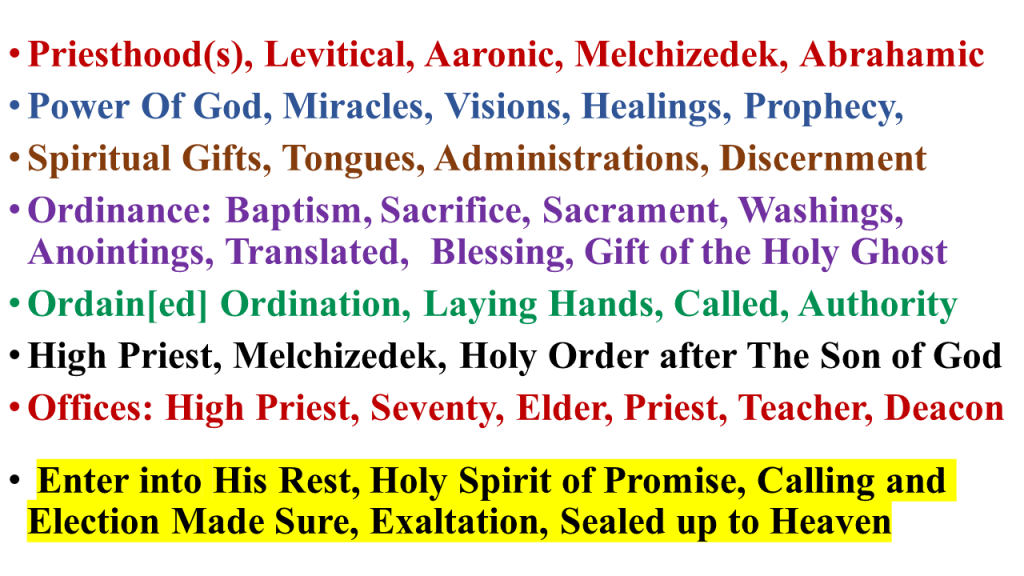
So, I go through the Book of Mormon and I start saying, ‘Okay, this word refers to the priesthood, this word refers to the priesthood.’ Well, I ended up with dozens of words that refer to priesthood power, and I became fascinated to see how most of the Book of Mormon does not refer to “keys.” Most of it refers to God’s power on earth. And this is how I felt when I finished going through the Book of Mormon.
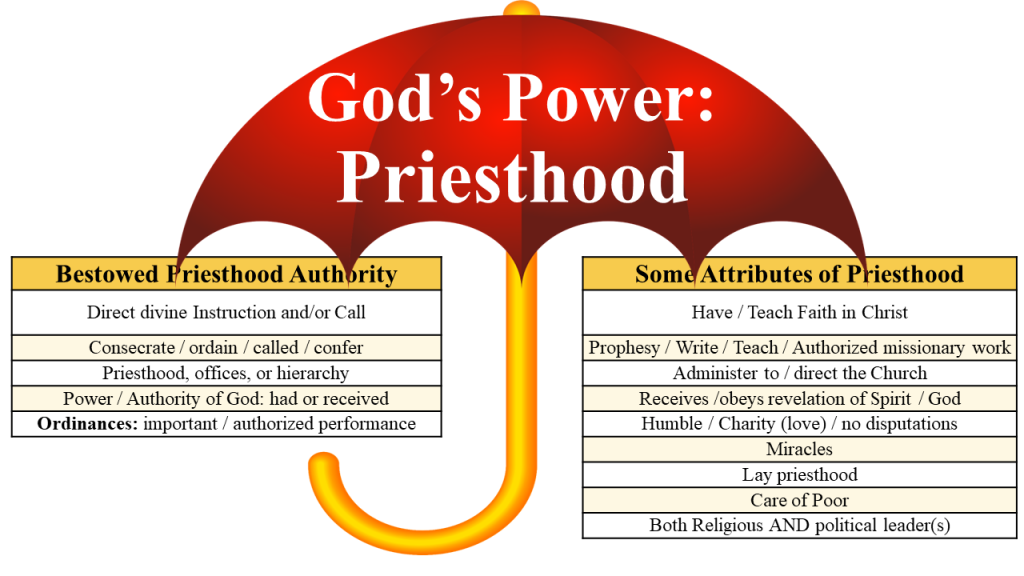
I called into some research associates to help me, and Dr. Cort Hilton organized this enormous amount of information in the Book of Mormon into two basic categories: information that is the bestowal of priesthood authority, and then some attributes of the priesthood. And each book was taken and divided up: not verse by verse, not word by word, but conglomerate.
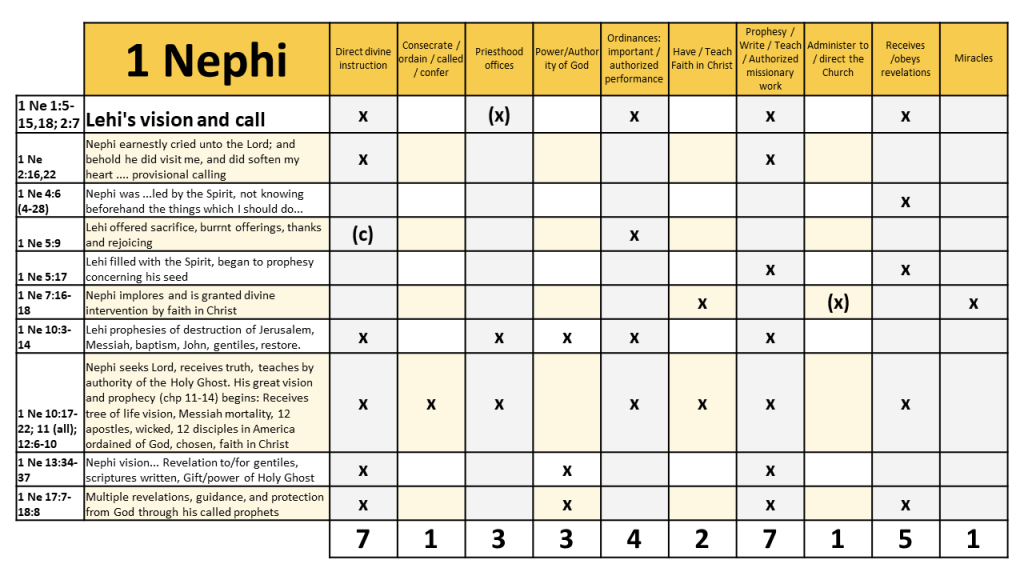
So, the first one in First Nephi would be Lehi’s vision and call. There are several verses there. And there are dozens of references to the priesthood in that section. If we’re looking at these larger words of ‘ordain,’ or ‘call,’ or ‘power from God,’ or ‘His Holy Order,’ or ‘was ordained after the Holy Order of God,’ things like that, which are key words that represent the priesthood in our definitions.
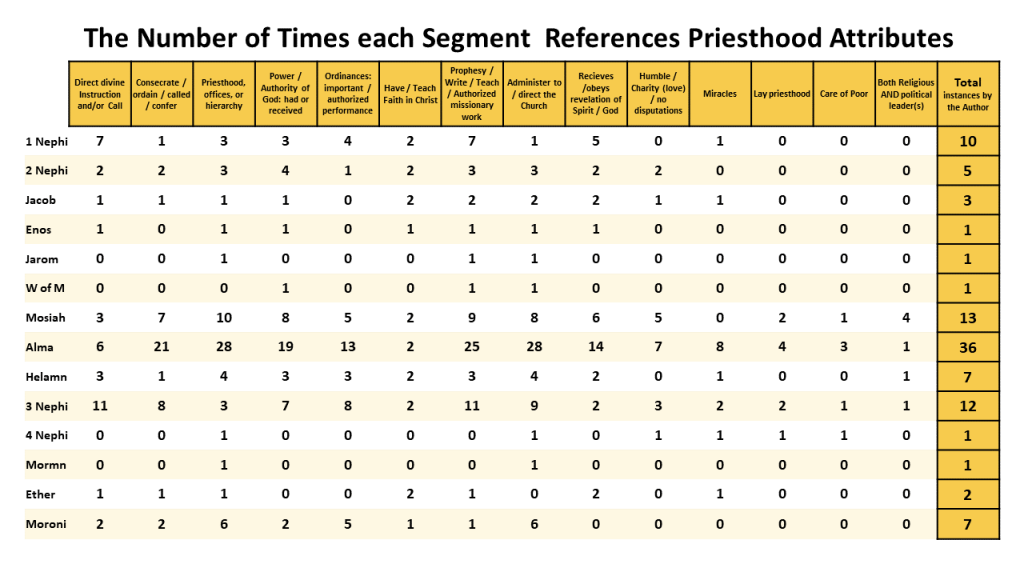
And then Cort Hilton did the same thing on all of these — you can see every single book has them. Just a phenomenal number of resources here.
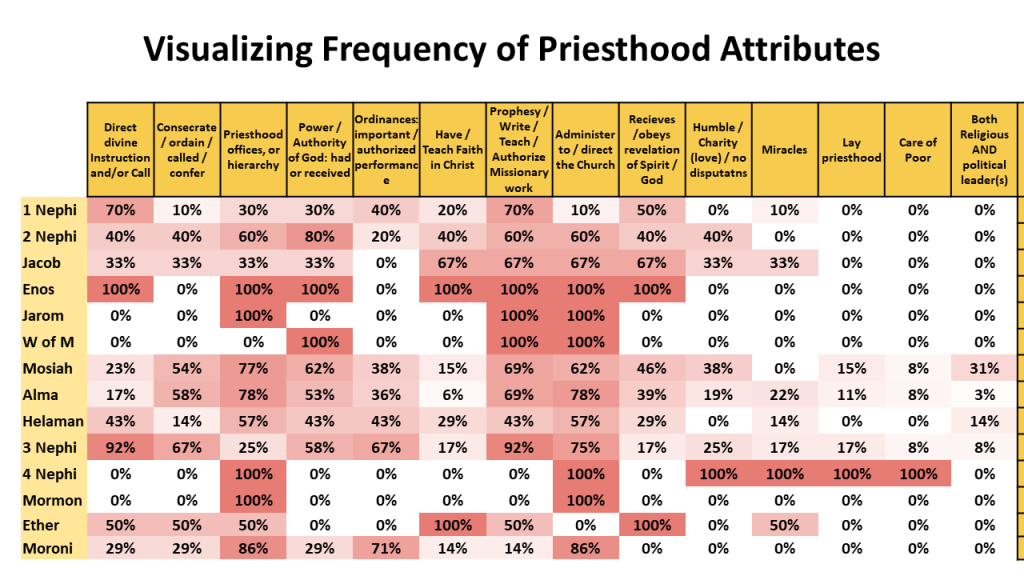
Another scholar helped me on this slide. He took each book, and where did they talk about the priesthood? And what did they talk about it? And do we see an emphasis?
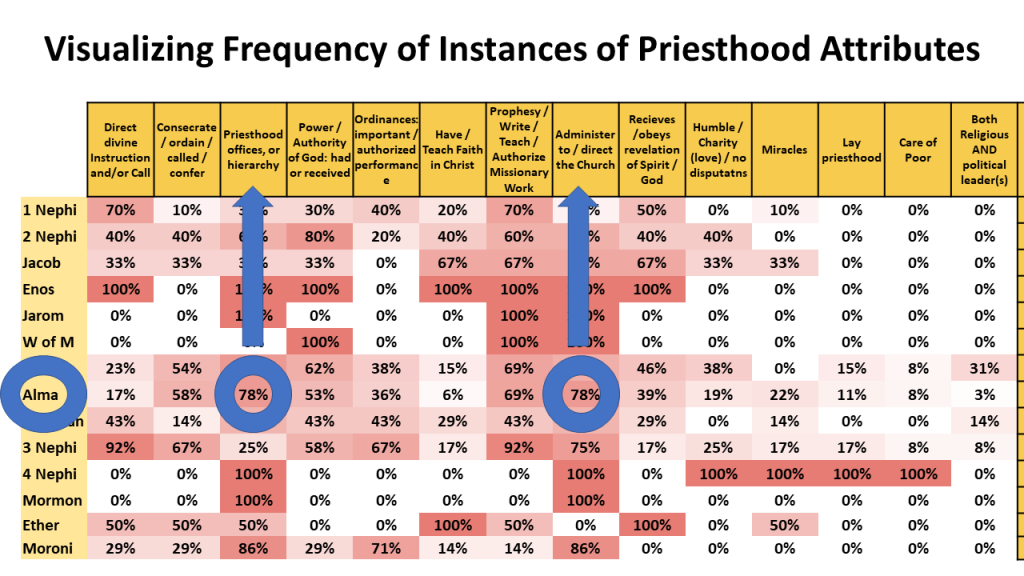
Now Alma talks about the priesthood more than anyone else. And I wasn’t surprised to find that in Alma’s collections, most of the references to the priesthood are about the organization, the offices, the church itself, directing it, because he’s the high priest, you know, this is his job, at least much of the book is written by him.
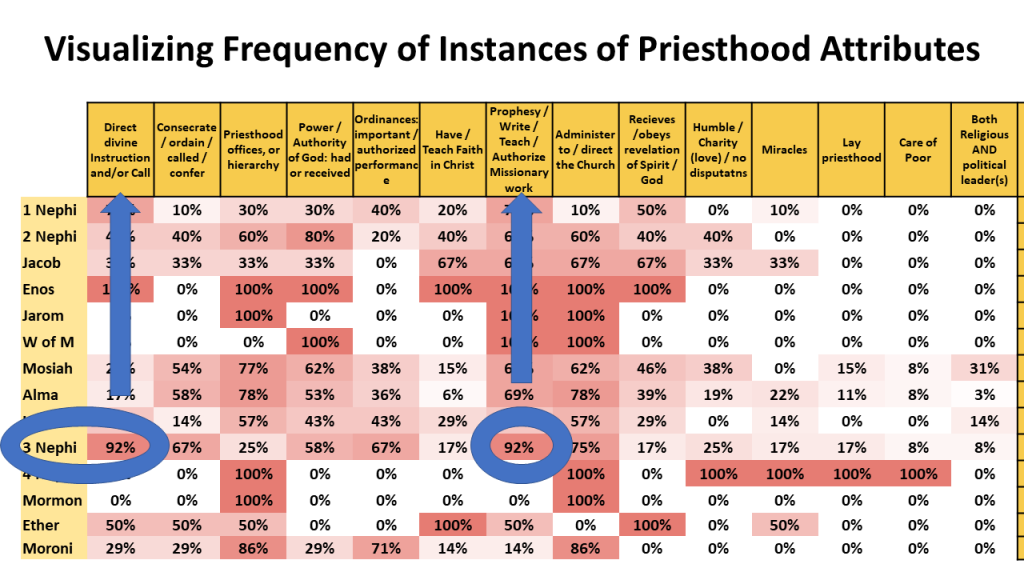
As we look down at third Nephi, most of the references on the priesthood come out of our Savior’s voice or the prophetic leading up to the Savior’s voice. And sure enough, we are very consistent there. 92% of the references to the priesthood deal with this divine direction, and instruction from God, or the need to be called, missionary work and record what’s being taught, things like that.
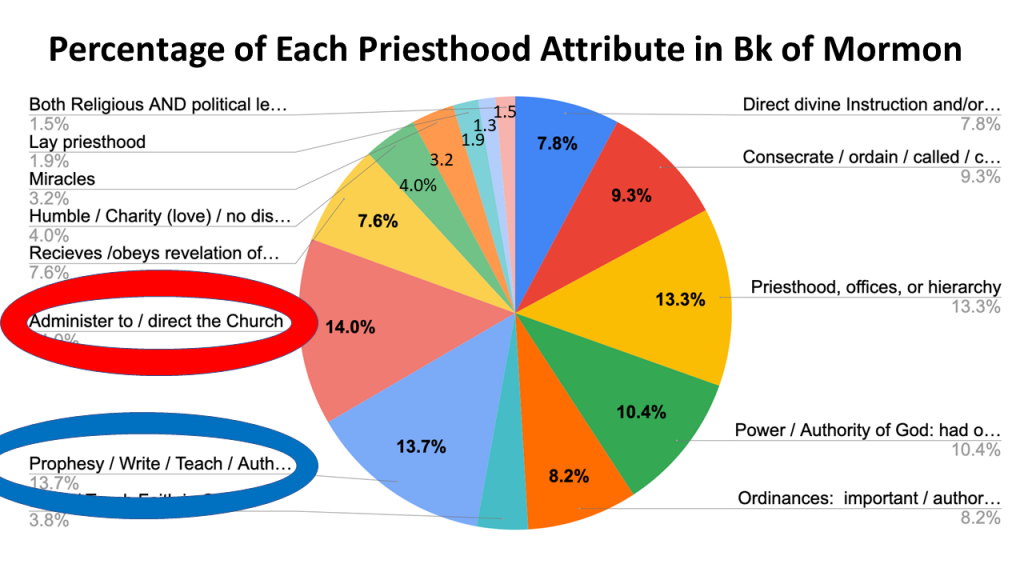
Another look at the Book of Mormon, how much of each book is attributed to having the priesthood as a theme. And this was very interesting: if we look at the entire Book of Mormon, 14% deals with the administration. And just below that – 13.7% – deals with prophecy and teaching and authority.
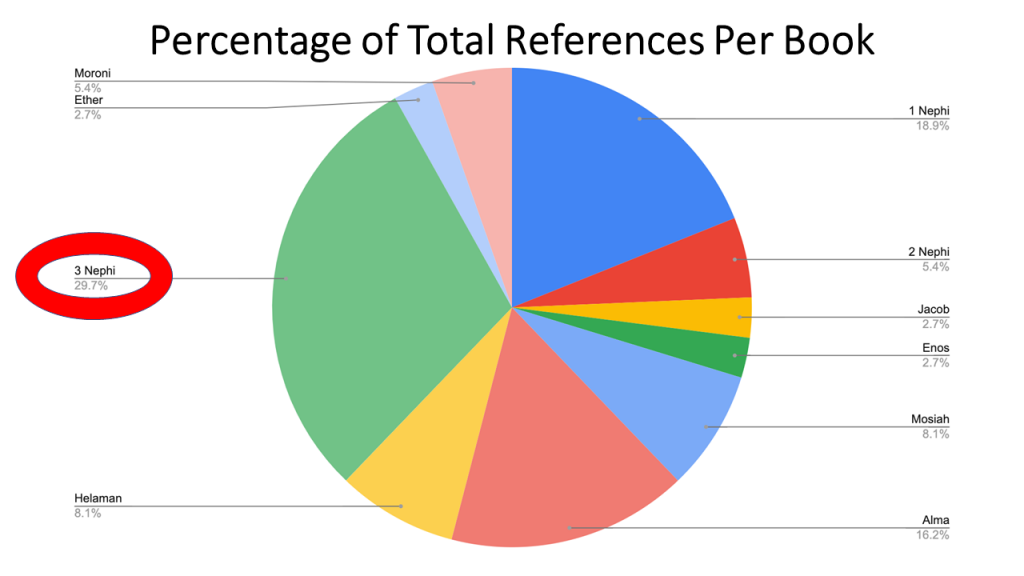
Then you can look at each book: 3 Nephi has a very large portion that discusses the priesthood or authority or the power of God on the earth, which is what Christ is doing as he comes back. This makes a lot of sense to me.
In addition to the Book of Mormon having this overarching view of the priesthood, I also wanted to look at the Doctrine and Covenants. And of course, that makes it tricky because I want to just look at the sections that Joseph restored.
A Priesthood Timeline
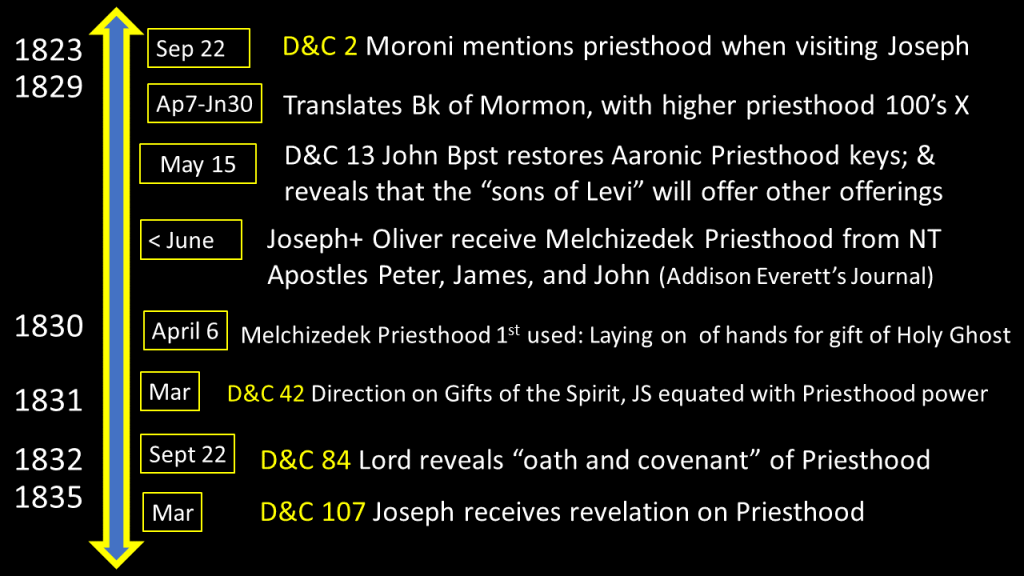 We start out with 1829. On May 15, section 13, John the Baptist’s record of the Aaronic priesthood being restored with those keys. “Upon you my fellow servants in the name of the Messiah, I confer the Priesthood of Aaron, which holds the keys of the Ministry of angels.”
We start out with 1829. On May 15, section 13, John the Baptist’s record of the Aaronic priesthood being restored with those keys. “Upon you my fellow servants in the name of the Messiah, I confer the Priesthood of Aaron, which holds the keys of the Ministry of angels.”
Joseph continued on, and according to some secondhand accounts, while Joseph is still down in Harmony translating (so before June is finished) in 1829, he receives the Melchizedek priesthood from the apostles Peter, James and John. But if we don’t want to believe Addison Everett’s account[3] and a couple of the Whitmer’s, then we need to say, ‘Well, we know for sure he had it before the organization of the church on April 6 1830, because that’s when the first time an ordinance was made under the power of the Melchizedek priesthood.’ – with the laying on of hands for the gift of the Holy Ghost.
But then we start seeing more sections. Doctrine & Covenants 42 gives this wonderful section on the gifts of the Spirit – which Joseph equated multiple times to the power of the priesthood, that all that gifts the spirit function as if they were being directed by God’s priesthood. And he doesn’t say ‘power of God.’ He says, ‘the priesthood.’
September of 1832 is when he receives the Oath and the Covenant of the priesthood. And then 1835 is when he gets this Section 107. So, as we look at the word ‘priesthood,’ it’s actually 126 times (but if you add an “s” or you add a few other little things around it, it’s approximately 130 times) in the Doctrine and Covenants.
I did not count anything like “the spirit.” I did not count that as priesthood, but I think Joseph Smith would have counted “the spirit” as priesthood power. But this was interesting, to see in the Doctrine and Covenants this many references just to this idea of priesthood power. Also interesting to me when we had the real first edition 1835, since the 1830, was destroyed by the mobs by 1835.
When they’re doing this edition, instead of putting them semi chronologically, they chose to organize the revelations by putting the priesthood ones first: of course, we have the preface, Section 1. And then we have the articles and covenants of the Church, which describe the priesthood ordinances. And then we have the oath and covenant of the priesthood, and Section 107, on the keys of the priesthood.
It lets you have a flavor of what Joseph felt, and the early church leaders felt, were most important to be communicated in their new book of scripture. When we were going through that calendar outline, I don’t know if you caught the fact that Section 84 came on the fifth anniversary of Joseph receiving the golden plates from angel Moroni.
Priesthood Restoration and the Hebrew Calendar
I think these dates are so significant because of their relevance in the Hebrew calendar as well. Remember, when Moroni comes, it’s on days like the Day of Atonement, and during the Feast of Tabernacles, and very significant dates in Jewish history and are exactly tied into the Restoration of the gospel.
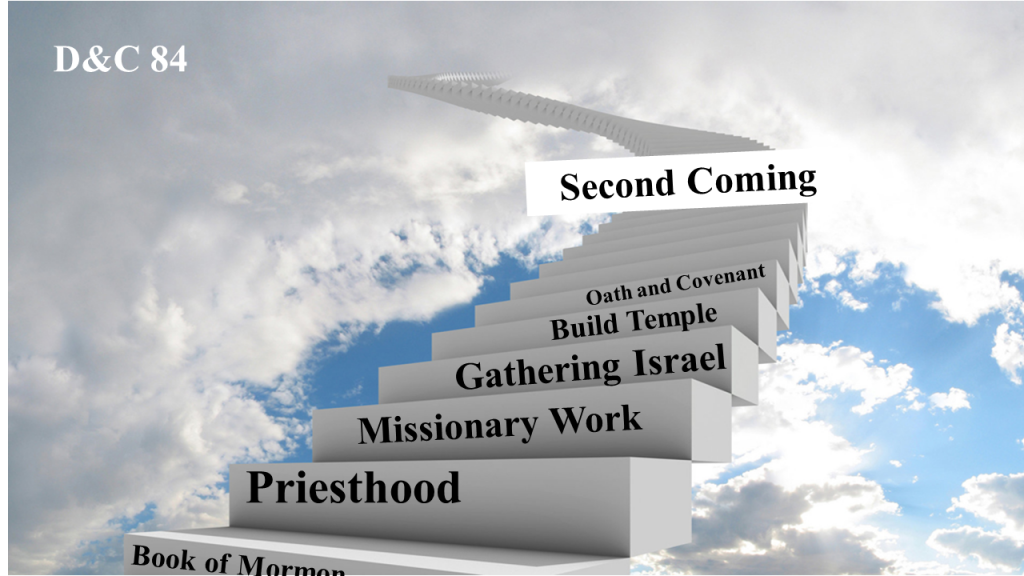
We see the same thing happening right here with the restoration of the oath and covenant of the priesthood in Section 84. As I took section 84 – I just wanted to organize it – I saw that the Book of Mormon is introduced first, and then building on the Book of Mormon is the topic of the priesthood. And then building on the priesthood is the call to missionary work to gather Israel.
And why do we need to gather Israel? So that they can go to the temple. And why did they need to? Why do they have to have the temple? To receive the covenants for the oath and covenant of the priesthood. And why do they need that? To become a kingdom of priests and priestesses in order to prepare the world for the second coming. It’s just a beautiful outline of how the Lord wants us to do things.
But section 84 almost entirely refers to the priesthood in this general sense of God’s power that’s available to all believers who will live worthy of it. And in fact, in Section 84, the Lord hearkens back to Moses. Verse 23 reads, that Moses “sought diligently to sanctify his people that they might behold the face of God.”
Calling Modern Israel
Joseph was called to do the same thing. He is calling modern day Israel to once again, climb the Mount; do not stay in the foothills any longer. We have stayed there with the children of Israel, and the early Christians did. And so, the Lord once again raised up a prophet and says, ‘Climb this mountain and enter into my presence.’
The Oath and the Covenant of the priesthood is divided into an “if/ then:” if you covenant to serve the Lord, magnify your service to Him, receive Jesus as your Redeemer, and live by every word of God, then you will be sanctified by the Spirit and receive all the Father has for you. This is the oath and covenant the priesthood.
Our prophet (Russell M. Nelson) had a great conversation at the restoration of the priesthood site with President Jean Bingham.
As stated in the first part, the prophet said the oath and covenant the priesthood is for women. In light of the Prophet’s statement, I want to go back to this famous verse, this scripture mastery verse, (Doctrine and Covenants 84:33) and read it as if it were written to women as well as men. “For whosoever is faithful, unto the magnifying their calling, are sanctified by the Spirit, and to the renewing of their bodies, and they become the church and kingdom and the elect of God. And also, all they who receive the priesthood receive me, saith the Lord.” This is just powerful.
Where Do We Talk About Priesthood Most
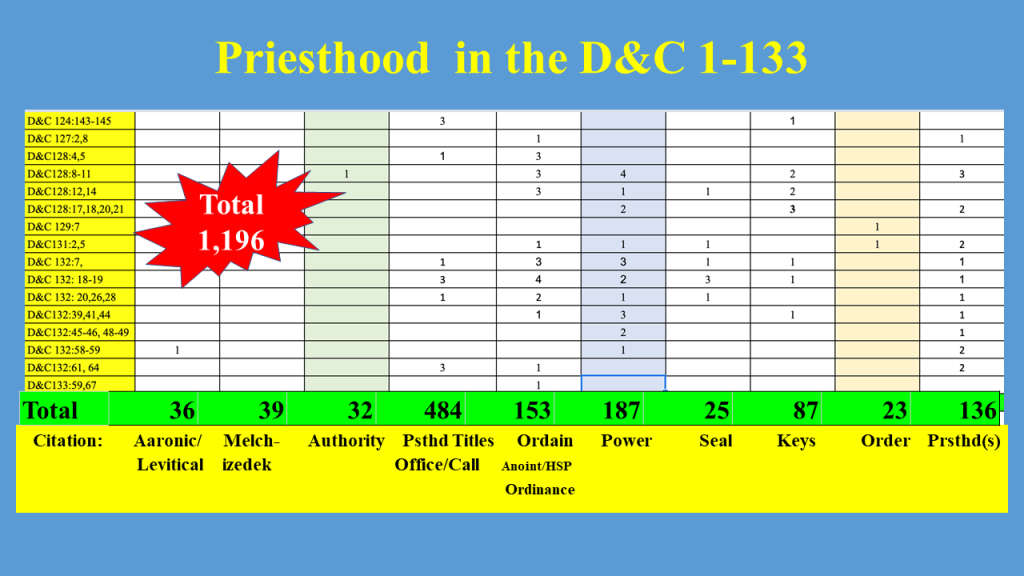
Going back to the rest of the Doctrine and Covenants as we leave section 84. It was interesting to me to see in the Doctrine and Covenants, where do we talk about the priesthood most? Well, the topics are priesthood titles, offices and callings. This is the organization of the church. The Doctrine and Covenants could be like the Book of Leviticus: it’s a priesthood manual for us.
I thought it was also interesting that the second most regular use of priesthood in the Doctrine and Covenants is under the idea of power: the power of godliness. I also wanted to just look chronologically at where the priesthood falls in, because of that statement, ‘oh, he never talked about it until the end.’ Let’s just look at it chronologically.
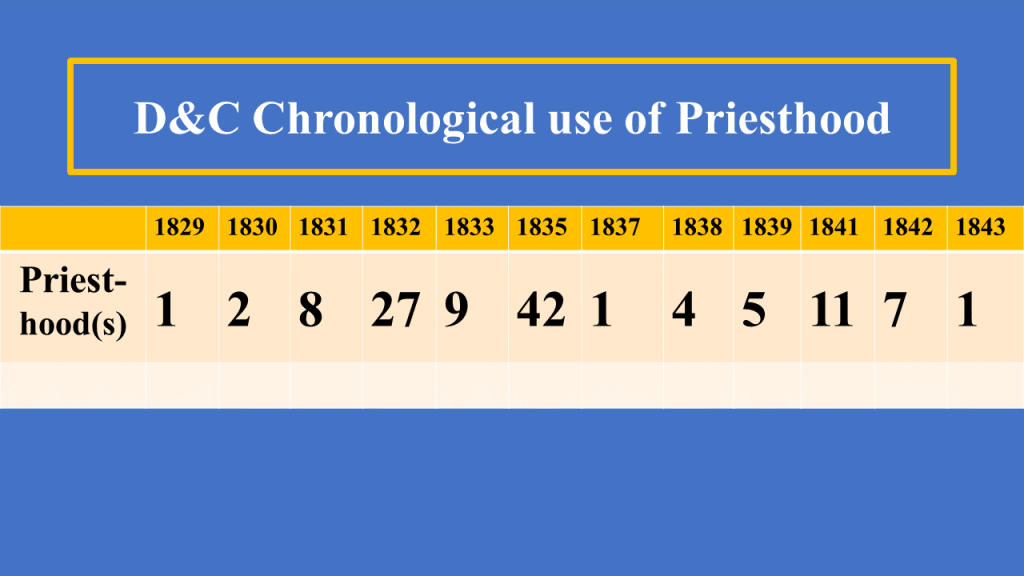
In 1829, we have one reference. 1830, 2; 1831, 8; 1832, 27; 1833, 10. Now, the reason why I put 10, there is because Joseph had learned about the celestial order of marriage, but he had not recorded it; but he had learned about it. So, the idea is that some of those numbers could go back to 1843, when it was published, but he did start teaching it at that point. And that’s why I put it there.
Remember, he doesn’t translate most of the Old Testament until the very end; he goes through Genesis 24. And then the Lord calls him to do the New Testament. When he finishes the New Testament, we have the last few months where they have the new system, and he translates the Joseph Smith translation of Genesis 25, through Malachi, with very, very few changes compared to the rest.
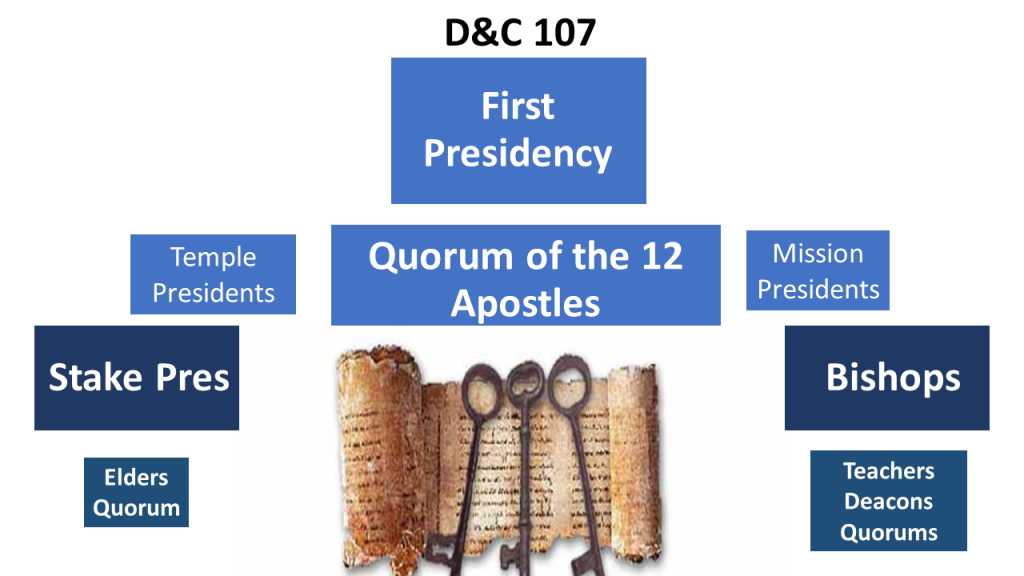
So that’s when I think he receives this revelation is during that 1830 period, 33 period. In my opinion, go ahead, throw rotten eggs. 1835. That is when the Oath and the covenant of priesthood comes in. 1835 is when section 107 comes in. So, this is on the keys of the priesthood. You see that one revelation really having a large portion of it. And of course, this revelation specifically is focused on the assignments that men have.
Now I am just chuckling because everywhere we go, we, my husband is a member of the 11th quorum of the 70. He has no keys. And, and people ask him to do things he says, ‘Go talk to your stake president – I have no keys.’ You know, these keys are held by very few people. You know, your Deacon’s quorum president has one, but not a member of the area 70. It’s just interesting to see how it’s outlined here for us.
Elder Oaks spoke on this one (before he was President Oaks) and he said, “Ultimately, all keys of the priesthood are held by the Lord”[4] Himself. Most of us here on earth just held them for a short period of time to do the Lord’s work. But they’re actually all his keys.” Continuing on, “Jesus Christ, and whose priesthood it is. He is the one who determines what keys are delegated to mortals and how these keys will be used.” And he’s saying we’re just his servants. We’re just trying to do it his way.
The Timeline Continues
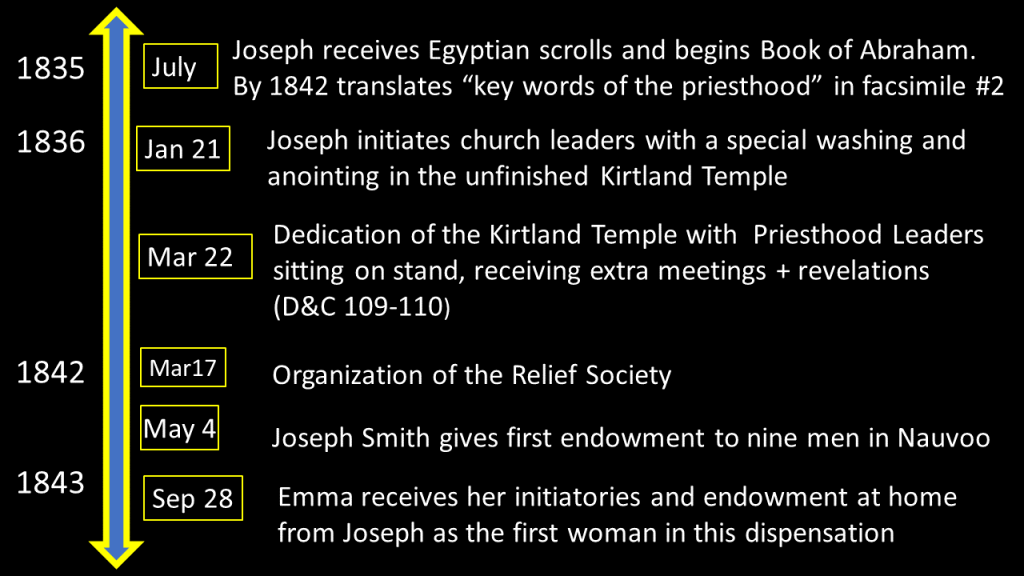
Going back to the timeline 1835. I already mentioned, Joseph receives section 107. But he also receives the Egyptian scrolls and he begins learning something about the Book of Abraham. Now in 1842, he publishes facsimile number two – but remember, the text for facsimile number two was never published. Joseph translated it but was never published.
We do not have in the Book of Abraham, anything that matches facsimile two, all we have is that nice little number seven definition, “This is God sitting on his throne, revealing the key words of the priesthood,” with all these stick figures (which are very clear, in my opinion).
1836 is when Joseph is able to restore the washings and anointings in preparation for the dedication of the Kirtland Temple. 1836 In March, until April 3, we have that beautiful dedication of the Kirtland Temple with the outpouring of Pentecostal gifts of the Spirit and marvelous manifestations and visions and all those extra meetings. And of course, Elijah comes in fulfillment of that prophecy by Moroni to restore the sealing keys.
The organization of the Relief Society was March 17, 1842. And then a month or month and a half, six weeks later, Joseph gives the first endowment to nine men in Nauvoo, and then in 1843, Emma receives her initiatories, and endowment.
As I looked at Joseph’s letters, and his sermons, again, I see an overarching definition that he uses for the power of the priesthood. I want to start with a letter that’s from Liberty jail. He’s already been there for a month, he’s in the height of emotional distraction, because the saints are still trying to get across the freezing plains of Missouri, out of the state. And he writes, “Dear, and well, beloved brethren, and when I say brethren we mean, those who have continued faithful in Christ: men, women and children.”
I take this definition and apply it to other things that Joseph says as well, especially at this time period. And remember this time period is when he also receives section 121 in Liberty jail, “Behold, there are many called, but few are chosen. And why are they not chosen? Because their hearts are set so much upon the things of this world. They aspire to the honors of men. And they do not learn this one lesson, that the rights of the priesthood are inseparably connected with the powers of heaven.”
The Powers of Heaven are Not Gender Specific
This is not gender specific. This is for all. Now, once Joseph gets up to Nauvoo, later that year, and he begins with a sermon in August of 1839, before he has malaria (I think, actually, he had it in June. So, before the second bout, I think). “The Priesthood is an everlasting principle, and existed with God from eternity, and will to eternity, without beginning of days or end of years. The keys have to be brought from heaven whenever the Gospel is sent…The power of the Melchizedek Priesthood is to have the power of ‘endless lives’… holding the keys of power and blessings.”[5]
Another sermon, January 6, 1842, “Jehovah has promised . . . his servants, to prepare the Earth for the return of his glory, even a celestial glory; and a Kingdom of Priests and Kings to God and the Lamb for ever, on Mount Zion, . . . in the restitution of all things.”
And this theme of ‘we have to raise up this kingdom of priests and priestesses in order for this Savior to come,’ is also stated in the book of Revelation. Do you remember chapter 19, we’ve got 101 verses on all the last-day destructions, all the seven plagues and all the misery that’s going to happen. Then finally, it says in chapter 19 (I think it’s verse seven, eight or nine, somewhere around there), the bride was finally ready for the bridegroom.
So, the bridegroom came. As soon as we’ve developed this kingdom of priests and priestesses as soon as we are ready for the second coming, it will come. We’ve had multiple general conference talks that have said, the church is wicked enough for the Second Coming. The problem is, the Saints aren’t ready.
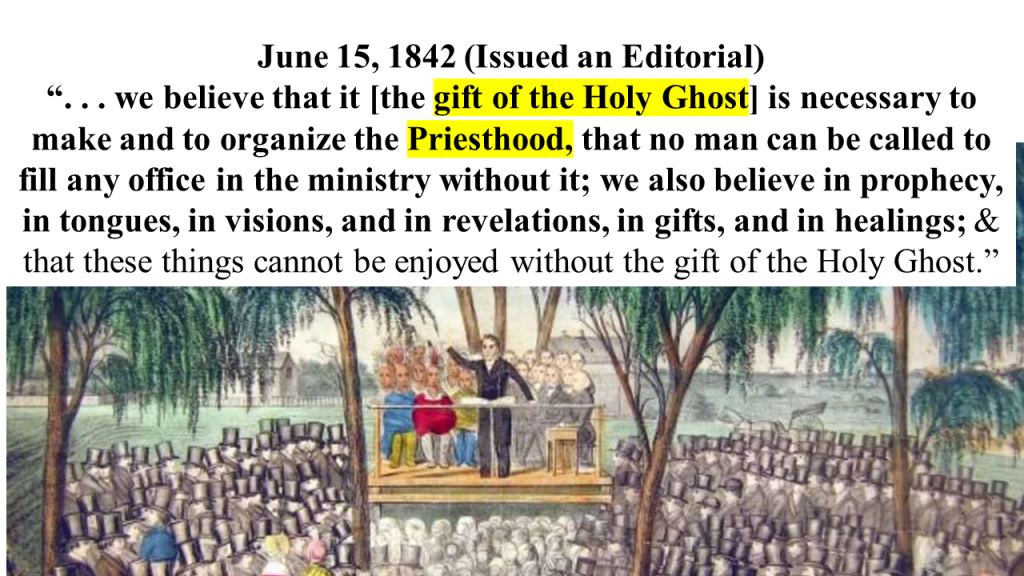
This was being taught by Joseph in 1842. In June (after the Relief Society is organized), “…We believe that it [the gift of the Holy Ghost] is necessary to make and organize the priesthood.” This was very confusing to me on my dissertation: 10,000 hours trying to figure out, ‘why is he calling the priesthood the gift of the Holy Ghost? [continuing quote] “That no man can be called to fill any office in the ministry without it;” Well, is he referring to the priesthood? The Holy Ghost? You know, I’m really puzzled over this.
[Quote continues] “We also believe in prophecy, in tongues, in visions and in revelations, in gifts and in healings; and that these things cannot be enjoyed without the gift of the Holy Ghost.” Joseph is constantly tying the priesthood power with the power of the Spirit.
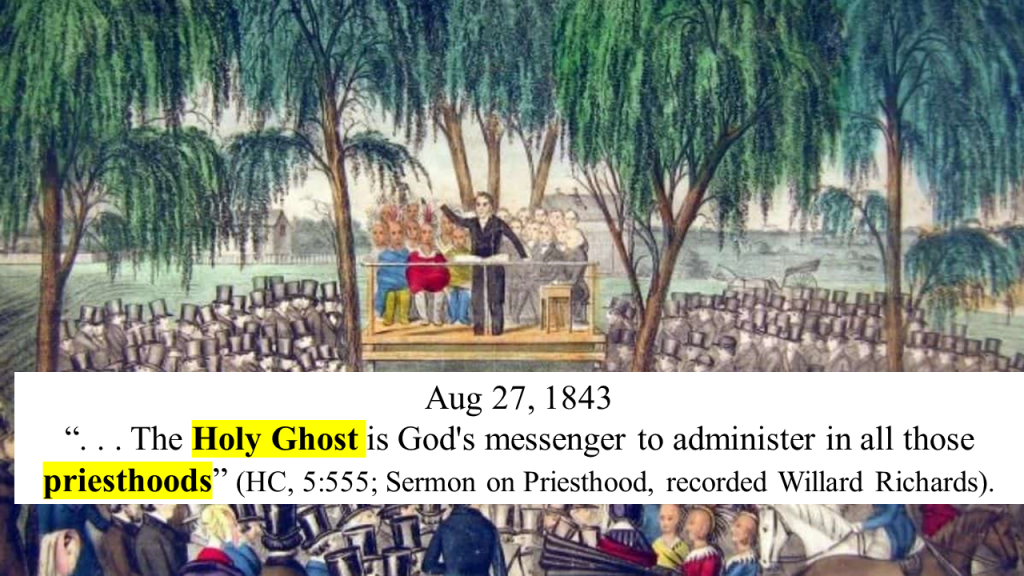
August 27, 1843. “The Holy Ghost is God’s messenger to administer in all those priesthoods.” This is just fascinating to me!
So, I continue to see this overarching view as we look at the history that Joseph restored. But let’s move on now to the second point on the organization of the Relief Society for future priestesses.
The Purpose of the Relief Society for Future Priestesses
Usually, we have Eliza R.’s (Eliza R. Snow) minutes, but Sara M. Kimball recorded part of this first meeting for us on March 17, 1842, up in the upper floor of the Red Brick store. And she said that when the Prophet organized the Relief Society, it was under the priesthood after the pattern of the priesthood. Well, I thought, ‘That sounds interesting. Haven’t I heard that word before somewhere?’ Or that collection of words? Where have I heard ‘under the priesthood?’
I do a little word search – It’s in Section 107. The office of an elder is under the Melchizedek priesthood. What’s the order of priesthood? I look that up. I see it all over the place. It’s the higher priesthood. Joseph is trying to raise up the Relief Society for these women to become priestesses, and he repeated it over and over at the meetings.
In the third meeting, in Eliza R.’s (Eliza R. Snow) notes, she records this as March 30, but Andrew Ehat had sent me an email a couple days ago and said it was actually March 31; Eliza got it wrong. But I had already turned in my slides. So, the handwriting says March 30, even if Eliza didn’t get the date right. (She didn’t have an iPhone, you know, what do you do?!)
“To make this society a kingdom of priests as in Enoch’s day, as in Paul’s day.” That was exciting to me. Because as we look at some of the early church writings, the early Christian church, we are having prayer circles with men and women praying. In fact, 1 Corinthians chapter 11 talks about the ordinance where the women have to veil their faces because it’s a sign of their power and authority to be functioning in that ordinance. So, this this was very exciting for me to see that.
Continuing on at this same meeting “…The society should move according to the ancient priesthood, hence, there should be a select society, separate from the evils of the world, choice, virtuous and holy.” Now, the reason why He’s emphasizing this is the meeting has – Relief Society – has already tripled in numbers, and he wants them to keep it small because he wants them to be worthy of becoming priestesses.
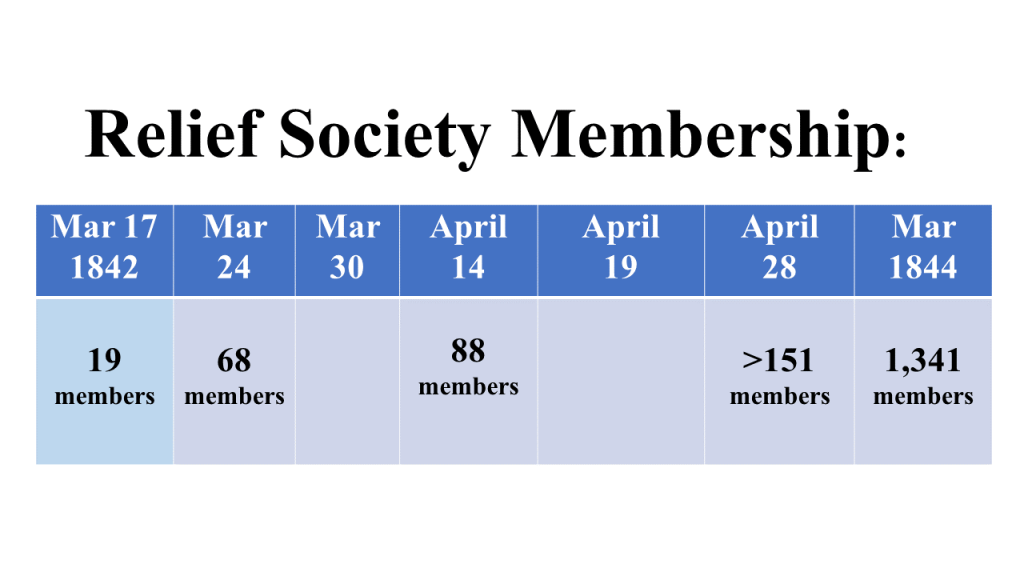
So, I just did a little number counting. And Eliza R.’s notes do not always list everyone who’s in the meeting attendance. So, some of the dates I wasn’t able to get it. But whenever Eliza R. (Eliza R. Snow) took roll, and I counted them up, and I got 19 women at the first meeting, and by the end in March of 1844, we have 1,341 members. The most famous meeting though, was April 28, 1842. And this meeting became known to the women as the ‘Prophet’s Revelation on Women.’
The Prophet’s Revelation on Women
[Joseph] gave a lecture on the Priesthood shewing how the sisters would come in possession of the privileges, blessings, and gifts of the Priesthood, and that the signs should follow them, such as healing the sick, casting out devils and that they might attain unto these blessings by a virtuous life and conversation and diligence in keeping all the commandments.[6]
Respecting the female laying on hands, he further remark’d, there could be no devil in it if God gave [H]is sanction by healing— that there could be no more sin in any female laying hands on the sick than in wetting the face with water— that it is no sin for any body to do it that has faith, or if the sick has faith to be heal’d by the administration.
And then Eliza R’s notes continue, “He reprov’d those that were dispos’d to find fault with the management of concerns—saying if he undertook to lead the church he would lead it right— that he calculates to organize the church in proper order.” He goes on, “If the sisters should have faith to heal the sick…let all hold their tongues.”
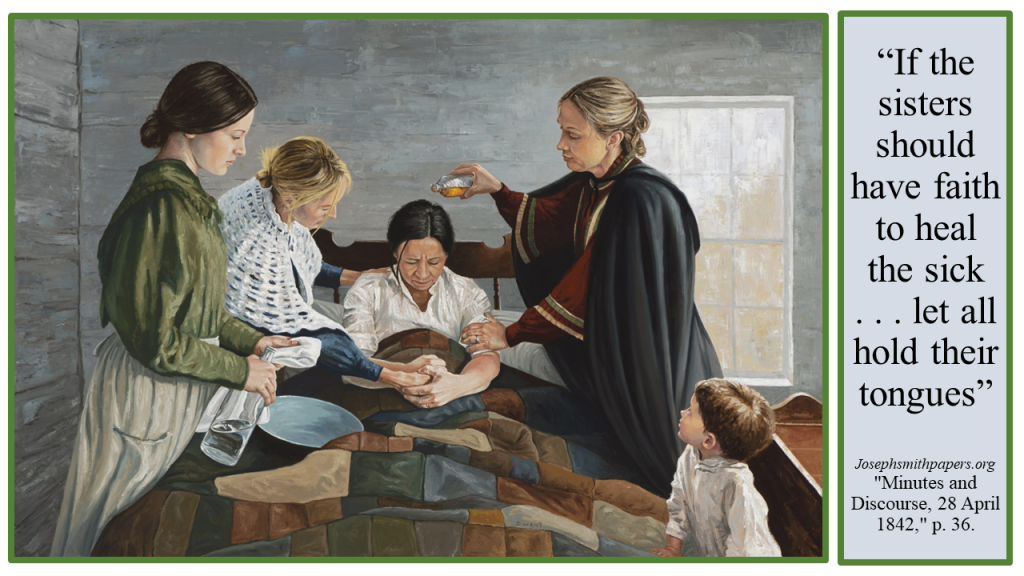
Now this artist has chosen to put the women’s hands on the expecting mother’s abdomen, and that was normal practice, you laid your hands on the area of ailment, and most illnesses when blessings were needed had to do with female issues for women, whether it’s mastitis or whatever, it would be inappropriate for an elder to come in and put their hands there. And it was very appropriate, and the women were the ones doing the deliveries at home in this time. And so labor and delivery was often accompanied not only by blessings, but later by washings and anointings.
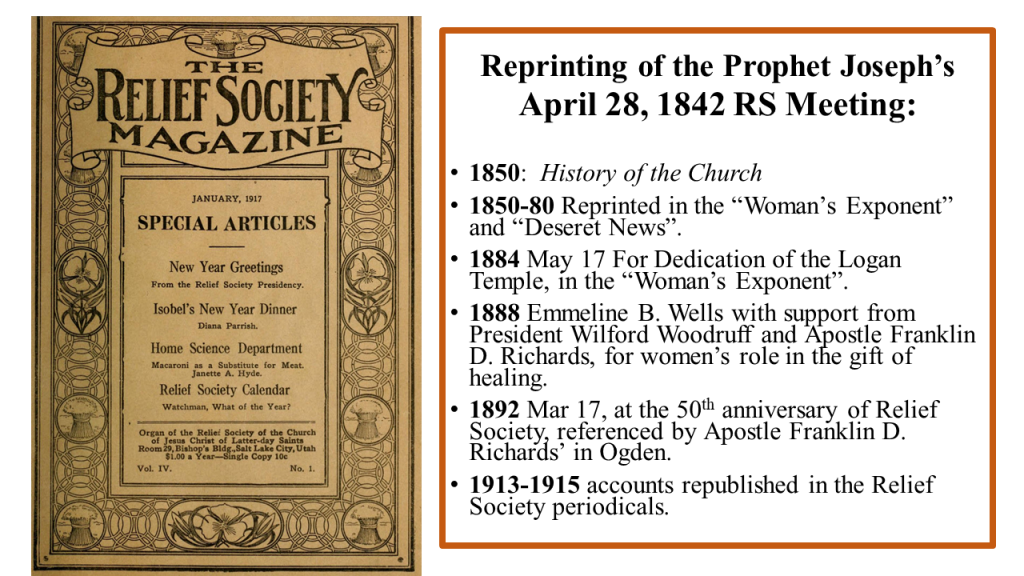
This sermon of April 28 became so beloved by the sisters, that it was republished and reprinted and recited and re-said, by so many people, and my slide goes through all of them. One of them actually was President Wilford Woodruff and the apostle and Franklin D. Richards, was read again. So, these are not just in the Relief Society magazine (that was just the picture that I got, because it was such a cool photo).
I would like to read to you a statement by Sister Carol Cornwell Madson, one of our fabulous scholars on this era.
Joseph Smith’s spiritually charged sermons to the members of the Relief Society, instilled in them a powerful sense of their worth as women as well as Latter-day Saints. He had a broad vision of the women’s role in the restoration and desire to teach them how they would come in possessions of the privileges and blessings of the gifts of the priesthood that accompanied the Restoration of the gospel. The Nauvoo Minutes, which inspired and guided the women of the church for several generations, indicated his hope to make of the society of Kingdom of priestesses, affirming its connection with the ordinances of the temple. The minutes tell of his delivering the sisters the keys of knowledge and intelligence and interpretation, both temporal and spiritual, in his encouragement, of their expression of the gifts of the Spirit, all of which gave these women a sense of full citizenship in The Restored Church.[7]
And it wasn’t just the Prophet Joseph either. Listen to what Brigham said. This is at general conference in 1844. And if I’m correct, I think this is the King Follet sermon-General Conference (but Joseph is on Sunday and I think he’s on Saturday). “I want a wife that can take care of my children when I am away, who can pray, Lay on Hands, anoint with oil and baffle the enemy.” He continues on later when he’s in Utah in the Journal of Discourses volume seven, “The man that honors his priesthood, and the woman that honors her priesthood will receive an everlasting inheritance in the kingdom of God.”
This idea was not shied even on our third Prophet, John Taylor, who when he’s ordaining and setting apart the third general Relief Society president Zina Young, he says, “Thou shalt have the gift to heal the sick.” And as I look back, there are patriarchal blessings given as far back as Joseph Smith Senior in 1836, where he is blessing women with a gift of healings. It’s just pronouncing that in their patriarchal blessings.
The Purpose of The Temple to Prepare a Kingdom of Priests and Priestesses
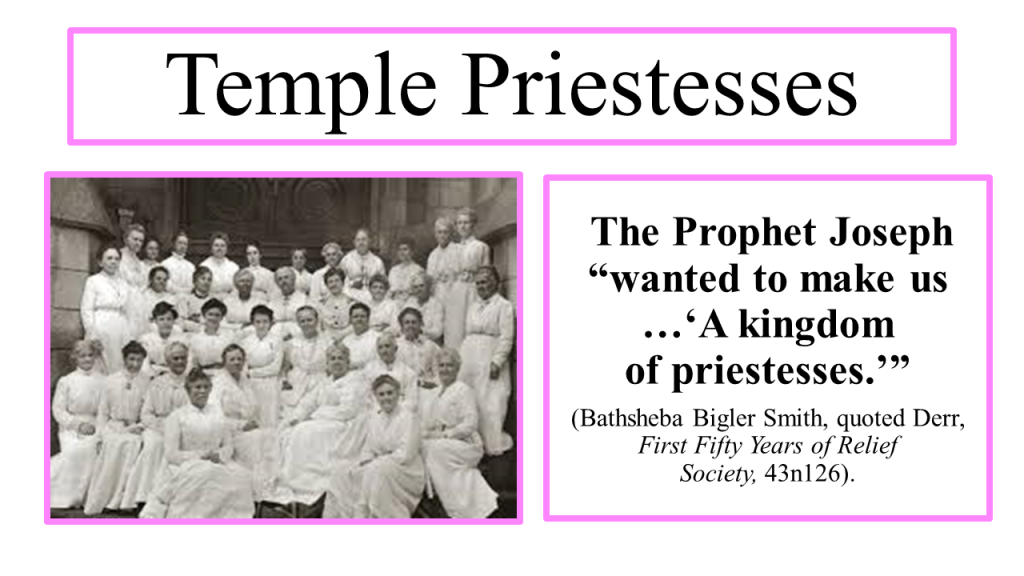
But as we go forward and look now at the order of the priestesses work in a temple – to the third point that I’d like to address – the Prophet Joseph is recorded in Bathsheba Bigler Smith’s journal as saying he wanted to make a kingdom of priestesses. We are hearing this in different settings by different women repeatedly because it was so important to them. This title meant something so unique.
Remember the 19th century women can’t own property, they can’t vote, their children aren’t even theirs. I mean, this is the 19th, early 19th century – Joseph is phenomenal. And this idea emits so much to the women, they’re recording these things. We also learned that in the Kirtland and Nauvoo temples in addition to the washings and anointings occurring and other ordinances later, healing blessings were also given.
Washings, Anointings, and Healings
But when Joseph first introduces the washings and anointings, they were done literally, not symbolically. And he describes in the history of the Church, which you can read now online on the Joseph Smith papers as well, that these men on that June 21, 1836, gathering where we had several come in – different quorums all through the night, and they’re having marvelous spiritual outpourings, and visions and blessings and healings – are literally being immersed and literally having their bodies anointed with perfumed oil, the whole thing.
Temple Prep
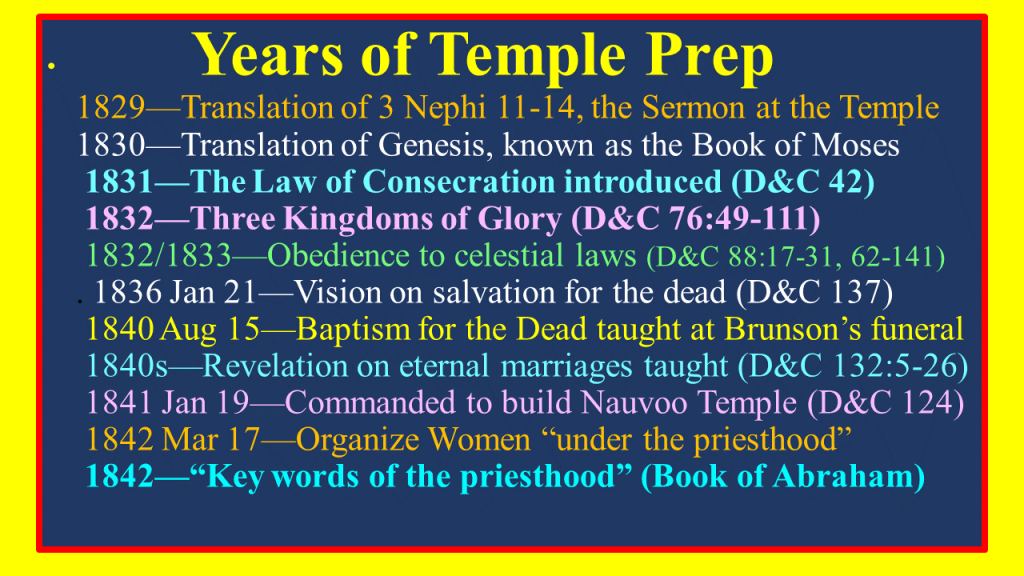
But as Joseph turns then to Nauvoo, and we see a temple prep, I decided I’d go back and say, “When did Joseph start learning about temples?” This is also something that was not part of the Protestant church. Well, in 1829, when he’s translating the Book of Mormon – has anybody here read Jack Welch’s book on the sermon at the temple? Where he looks at Matthew chapter three, four, and five as different thing from third Nephi. And where are they different? And he talks about this in the context of how it’s actually the same material that’s given in the temple endowment. This is a temple text.
So, I believe when Joseph starts that translation is his first introduction to ideas that will become the temple text. In 1830, he translates the book of Genesis, which is now our book of Moses. In 1831, the law of consecration is introduced as soon as Joseph gets to Kirtland, here just a couple of days after he arrives. 1832, The Three Degrees of Glory. 1833, obedience to the celestial laws in Section 88.
January 21(1836), I already mentioned the visions and for the salvation of the dead that accompany this first time when they were having the washings and anointings. April 3 of 1836, Elijah restores the sealing keys. August 15 of 1840, baptisms for the dead is taught at Seymour Brunson’s funeral. January 19, 1841, he’s commanded to build the Nauvoo Temple. And then just the year later, March 17, 1842, the women are organized under the priesthood after the order of the priesthood to become a society of priestesses. In 1842 he also then publishes for all to read and see in the Book of Abraham, these key words and signs according to the holy priesthood.
The First Endowment
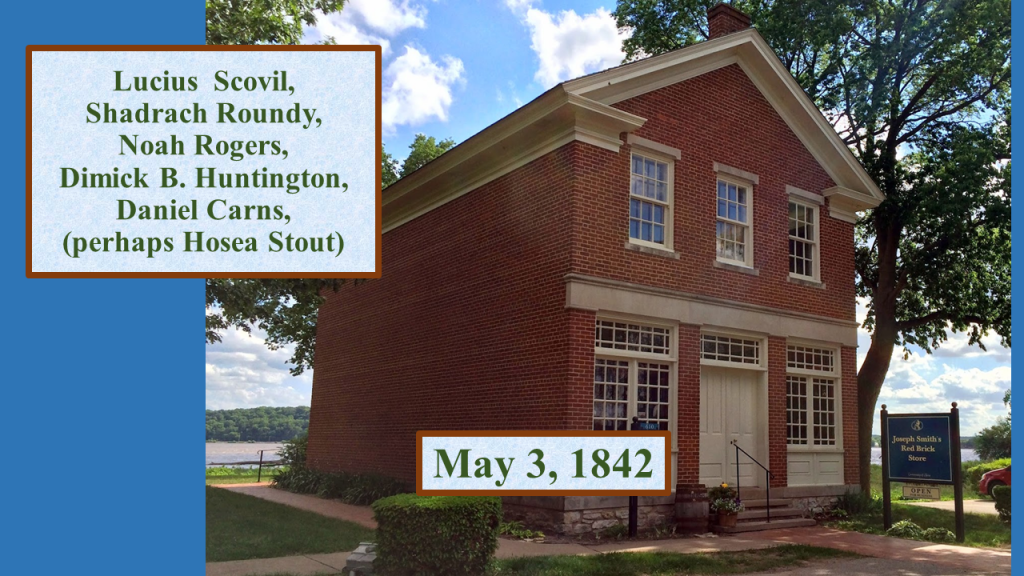
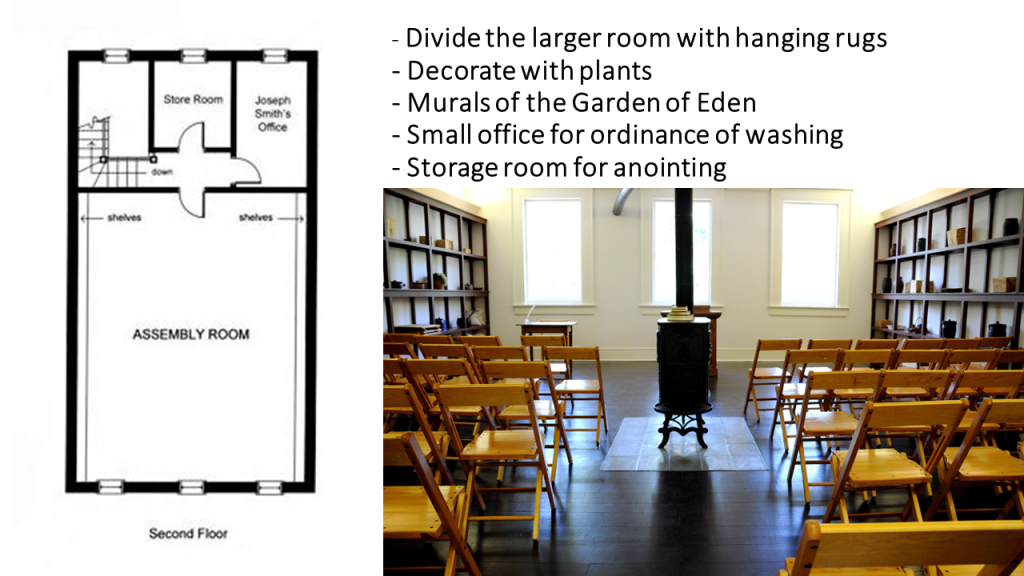
The first endowment was given in the upper floor of the red brick store on May 4, 1842. But the day before he has five or six friends come, and they try to transform this little room like the temple had been. And as you recall the descriptions in Leviticus and Exodus, the tabernacle Holy of Holies and holy place, it’s supposed to look like the Garden of Eden. And that’s just what they did. They brought in murals and carpets and plants, and they used the storage room and Joseph’s office for washings and anointings.
Joseph recorded in his journal for May 4 that “Wednesday night, I spent the day in the upper part of the store, introducing them to the principles of the Order of the priesthood, attending the washings and anointings and endowments and communications of keys pertaining to the Aaronic priesthood and so on until the higher order the Melchizedek priesthood, setting both down the order pertaining to the Ancient of Days,” That of course, is Adam, “and all those principles by which anyone is enabled to secure the fullness of those blessings and abide to the presence of Elohim in the eternal worlds. In this council was instituted in the ancient order of things for the first time in these last days.”
Just a year and a month later, Joseph records in this sermon to the saints, “What is the object of the gathering of Jews?” And then he answers it: “The main object was to build unto the Lord a house whereby he could reveal unto the people, the ordinances of his house and the glories of His Kingdom. It is for the same purpose that God gathers today that people are the last days to build unto the Lord an house to prepare them for the ordinations and endowments and the washings and anointings.”
Emma Receives Her Endowment
Late that year, in September of 1843, Emma is ready and willing to obey all that God has commanded her. Joseph is able to give her initiatories and her endowment in their home, in a private room upstairs in the mansion house. A few days later on September 28, at 7pm it is recorded in the Joseph Smith Papers and the Journal’s volume three, “in a separate ordinance performed the following September, Joseph and Emma Smith were anointed and ordained to the highest and holiest order of the priesthood.”
And now I’d like to read brother Ehat’s words on this from his dissertation. “In many ways, the 28th of September 1843, must have been one of the greatest days of Joseph Smith’s life. He had seen the inauguration of the highest ordinances that it was possible for any man or woman to receive in mortality.”
Emma Gives the Initiatory to other Women
Shortly after that time, Emma is able to now begin giving the initiatory (the washings and anointings) to other women who are in the Relief Society. And the first ones were Vilate Kimball, Leonora Taylor, Elizabeth Ann Whitney, Harriet Adams, Mary Fielding Smith, Mary Ann Young, Mercy Rachel Fielding, and Jennetta Richards.
These women (five of whom were apostles’ wives) had so many trials in their lives, and they remained faithful. And I honor them today. Those women became the core as well as adding up to 29 women by 1843.
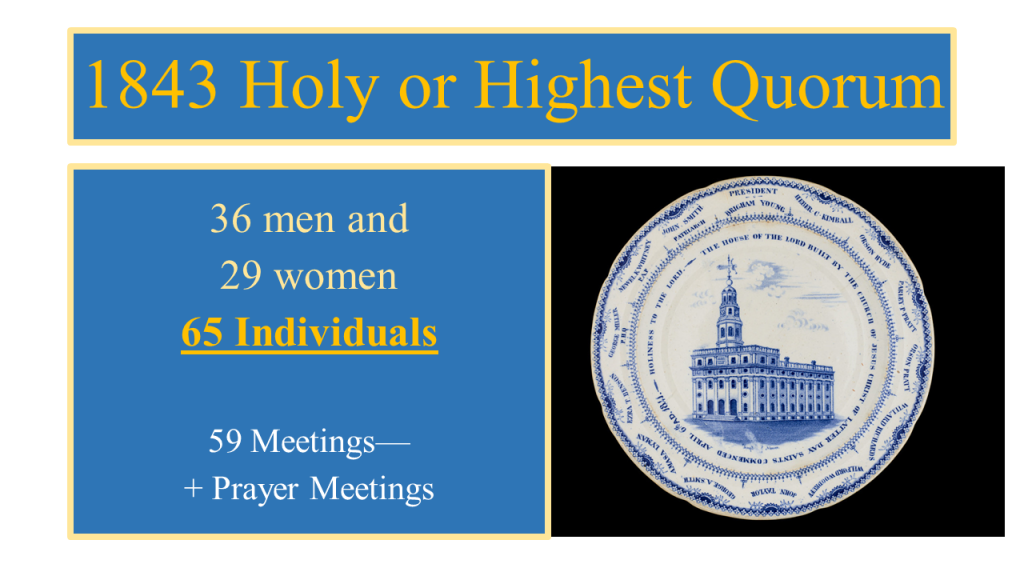
Later that year, in December, who formed a quorum that Joseph referred to as the “High Quorum” or the “Holiest Quorum.” That highest or holy quorum turns out to be 65 members in total, 36 of whom were men. We have records of 59 meetings that they held and other prayer meetings in addition to that.
Joseph Taught the Order of Prayer
We learned something about one of the meetings from Bathsheba Smith, who recorded “once when speaking, at one of our general fast meetings, Joseph Smith said that we did not know how to pray to have our prayers answered. But when I and my husband had our endowments in December of 1843, Joseph Smith presiding, he taught us the order of prayer. Joseph Smith publicly explained to the saints that in the endowment, they would be taught essential teachings on prayer, and on angelic ministrations.”[8]
I appreciate the scholarship of Jonathan Stapley and Kristine Wright now, as they summarize the next portion of history from 1877 to 1921. As more temples are built, remember, there’s a 30-year hiatus between Nauvoo and St. George as the next one. And then we have another decade or so before we get Logan.
“Temples were locations for special healing; and female as well as male temple workers regularly administered healing rituals to patrons. In all of these ritual modes, women frequently administered with men, uniting in faith for the physical restoration of their people.”[9]
Eliza R. [Snow] is one of those records that I really appreciate for accuracy, in her journals. In 1874, she’s speaking to a group of women. “You occupy,” — and remember, this is before the next temple; the last temple was Nauvoo. Okay, so they’ve got the endowment house and they’re doing washings and anointings to women in their homes. But this is 1874:
Women Share in the Gifts and Power of the Holy Priesthood
“You occupy – you women, – a more important position than is occupied by any other women on the earth sharing in the gifts and power of the holy priesthood, participating in those sacred ordinances without which we could never be prepared to dwell in the presence of the holy ones.”
And then again, Eliza R. [Snow] says at another public meeting in 1884 (I believe this is in conjunction with the Logan temple dedication):
Any and all sisters who honor their holy endowments, not only have the right, but should feel it a duty, whenever called upon to administer to our sisters in these ordinances, which God has graciously committed to His daughters as well as to His sons; and we testify that when administered and received in faith and humility they are accompanied with all mighty power.[10]
Joseph F. Smith, in 1907, then recorded in the Improvement Era: “It is no uncommon thing for a man and wife unitedly to administer to their children, and the husband being mouth, he may properly say out of courtesy, ‘By authority of the holy priesthood in us vested.’”[11]
He felt so strongly about it, that on December 21 of 1908, he formulated a first presidency letter to clarify exactly what this should entail. I think I’m going to read it from here because this is a little bit hard to read:
… inasmuch as they do it in a proper way, that is, in the spirit of faith and prayer, and without assumption of special authority … But if sisters have faith (emphasis added) enough themselves to ask worthy women to thus petition the Lord in their behalf, as they would ask the elders to administer to them, there need be no hesitation whatever on the part of discreet worthy women administering to their faithful sisters in this way. And we may add that such women may thus act whether the person administered to shall have received her endowments or not; and no member of the Church therefore need be barred from receiving a blessing at the hands of faithful women inasmuch as she has faith enough to desire and ask that this be done in her behalf.[12]
Female Healings Cautioned
I couldn’t turn my pages fast enough. In addition to the encouragement, there was also caution. This caution came from the General Relief Society President in 1900: “The sisters officiating, uniting their faith simply do so in the name of Jesus, not mentioning authority.”[13] She’s just cautioning these women.
June 29, 1821. Again, the General Relief Society board: “The giving of blessings and administering by women, were apparently carried too far. There was a ruling made that the women should administer only in the case of expectant mothers and when the priesthood could not be obtained.”[14]
Now part of the problem was, the germ theory has been discovered, we’re washing our hands. Hospitals have been growing. women are going to hospitals to have their babies: it’s not appropriate to have a washing and anointing ceremony prior to a birth if you are in a hospital room, with other people in the room. The caution became very much an issue of: are we in a doctor’s office, or are we in the home?
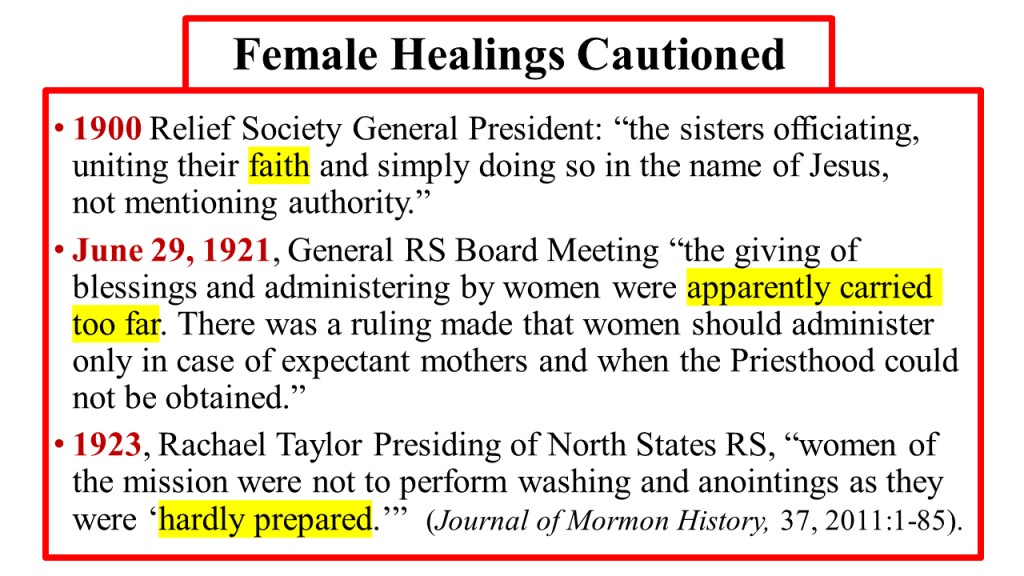
Again, in April 1923. Another word of caution, by Rachel Taylor, who is presiding in the North States Relief Society, and she is very concerned because women of the mission were not performing the washings and anointings as they were supposed to, they were not prepared. And here they’re doing these things in conjunction with blessings, and they were doing it wrong. And so, they just put out these words of caution.
In 1955, President Joseph Fielding Smith, then acting as the president of the Twelve, quoted his father in the Improvement Era again, as saying, it was “no uncommon thing” for men and women to join their faith in administering to their children in their homes. This though, is the last time that we have a reference to women administering in a public church.
Quotes About the Priesthood Power of Women in Our Days
However, there are many other places that we can go to look for women utilizing the priesthood in their lives. Let’s start with President James E. Talmage.
In the sacred endowments associated with the ordinances pertaining to the House of the Lord, woman shares with man the blessings of the Priesthood. (Emphasis added) . . .Then shall woman reign by Divine right, a queen in the resplendent realm of her glorified state, even as exalted man shall stand, priest and king unto the Most High God. Mortal eye cannot see nor mind comprehend the beauty, glory, and majesty of a righteous woman made perfect in the celestial kingdom of God.[15]
I remember President Kimball as a prophet (I was a young child) and he taught, “We are born to become kings and queens, priests and priestesses for our Lord.” The Encyclopedia of Mormonism: “The fullness of the priesthood is shared by husbands and wives who are sealed in the temple.”[16]
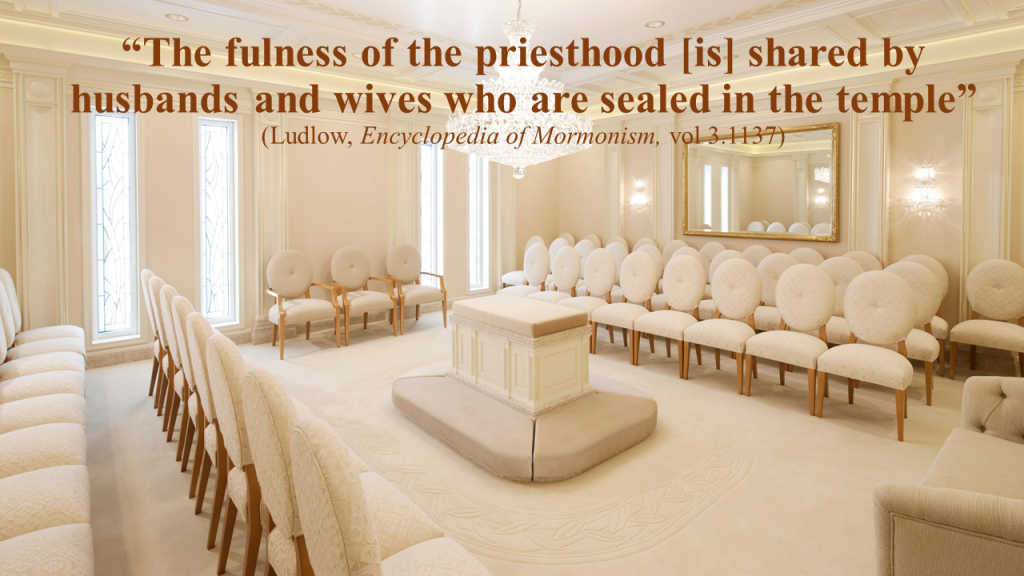
Elder Ballard: “In the eternal perspective, both the procreative power and the priesthood power are shared by husband and wife.”[17]
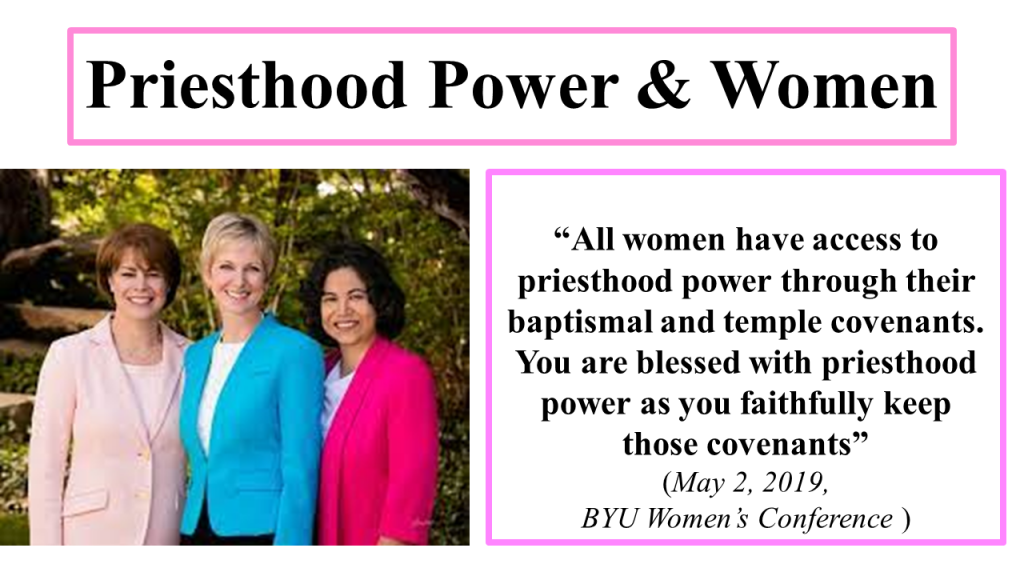
But lest anyone can be concerned about our wonderful single women in the church, our terrific General Relief Society presidency said on May 2, 2019, “All women have access to priesthood power through their baptismal and temple covenants. You are blessed with priesthood power, as you faithfully keep those covenants.”
Our Prophet said something very similar in the October conference of 2019. “In the Holy Temple, you are authorized to perform and officiate in priesthood ordinances. As your understanding increases, and as you exercise faith in the Lord and His priesthood power, your ability to draw upon this spiritual treasure that the Lord has made available to you will increase.”[18]
President Oaks has then stated in 2020: “The power of the priesthood exists both in the church and in the family organization. But priesthood power and priesthood authority function differently in the church than they do in the family. And this is according to the principles the Lord has established, the purpose of God’s plan is to lead his children to eternal life.”[19]
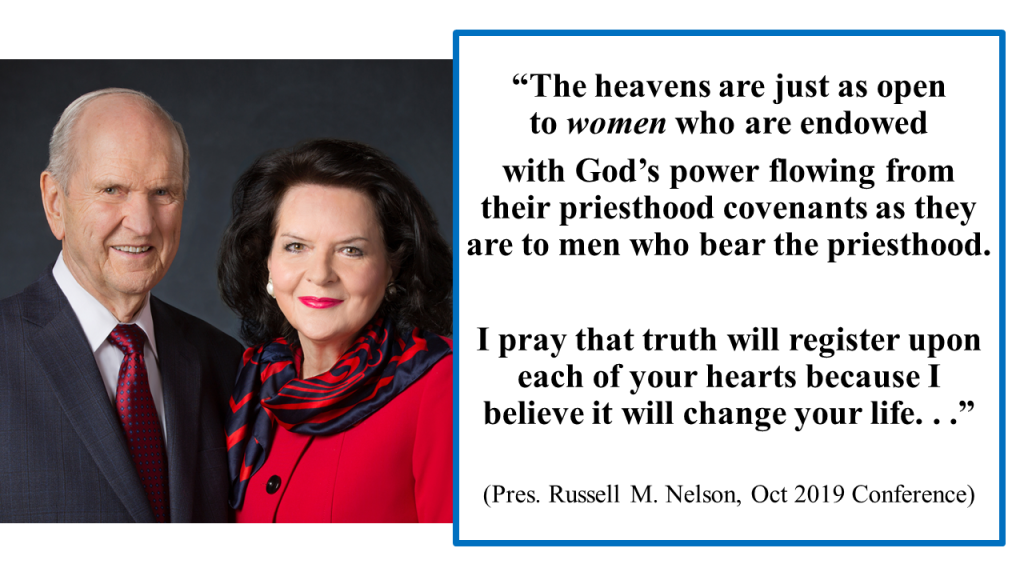
Our modern-day prophets again refer to a larger scope of the priesthood, blessing men and women. The prophet (Russell M. Nelson) again: “The heavens are just as open to women who are endowed with God’s power flowing from their priesthood covenants as they are to men who bear the priesthood.”
Concluding Thoughts and Personal Witness
I pray that this truth will register upon each of your hearts because I believe it will change your life. And now in conclusion, let us follow the Prophet and pull down the powers of heaven. My prayers have led to many miraculous healings, and I know of many other women and children who have the gift of healing. I know of one who has raised her daughter from the dead.
A Parallel Path
Like the children of Israel, God has called us to ascend to the top of the mountain, join Moses and the children of Israel. But this time, let us climb the mountain together to enter into His presence. I’ve been told that men have a visual priesthood path to serve in the church and build the kingdom. But what I’ve tried to teach is that our Prophet Joseph gave the sisters a parallel path, a parallel organization to build the kingdom, in their organizations and in their temple services.
The Rights of The Priesthood Are Inseparably Connected with The Powers of Heaven
And it is our Lord who has taught that the rights of the priesthood are inseparably connected with the powers of heaven. It’s the powers of heaven that cannot be controlled or handled only upon the principles of righteousness. We need to deny ourselves of all ungodliness to become priests and priestesses. That should be our walk and talk of everyday lives. I pray in the name of Jesus Christ, amen.
Q&A With Lynne Wilson
Scott Gordon
We got a number of questions all on the same subject, but there’s one that summarizes it here at the bottom. Given all that you have said, why do we stop short of saying women hold the priesthood? Why do we stop short of saying that?
Lynne Hilton Wilson
I think it’s a matter of defining how the word is used. I heard many times the prophets say, and Joseph, the women are priestesses.
Scott Gordon
And then there’s a number of questions – one after another – that talk about women laying on of hands. Why? Why is it considered sinful to do that? If my child is sick, is it appropriate for me to lay hands on my child?
Lynne Hilton Wilson
You know, this is really a delicate subject. And as a mom, who has prayed many times over my children and seen miraculous healings, I feel the Lord has used his priesthood power to heal them. But because things have changed does not mean that our current Prophet in this last two conferences ago, has encouraged us to utilize our faith to accomplish God’s work on Earth.
So, because it is not appropriate currently, to lay hands on, does not mean healings are to ever have stopped. There was misuse, it was – people before us used it incorrectly. I don’t think we need to blame all of the children of Israel for having the lower law. But they all had to live the lower law because their forefathers used it incorrectly. I see that personally as the answer; but God will heal any woman with faith who is kneeling by the bedside of that child, if it is His will for that child to be healed. I have seen it multiple times.
Scott Gordon
Okay, let me ask you one more. If approved by church leaders, what would you think of Relief Society presidencies ordaining women as ministers?
Lynne Hilton Wilson
If approved by church leaders, I’ll do anything – I follow the Prophet. I am a wing man for our Prophet. The only way we will become a kingdom of priests and priestesses is if we follow the Prophet: I will. The Prophet has asked us to utilize the priesthood power in our endowment more. I think he is calling us women to draw on the powers of heaven. Utilize this gift that you’ve been given.
Scott Gordon
And I think we see that with the sister missionaries more and more to how they’re being taught. Thank you so much. We appreciate your time.
Investigate Further
“‘Something Better’ for the Sisters: Religious Studies Center.” “Something Better” for the Sisters | Religious Studies Center, https://rsc.byu.edu/joseph-smith-doctrinal-restoration/something-better-sisters.
The Two Trees – Valerie Hudson, FAIR Conference 2010
Mormonism, women and the priesthood
Question: Did Joseph Smith intend to ordain women to the priesthood?
References
[1] Nelson, President Russell M. “Spiritual Treasures.” The Church of Jesus Christ of Latter-Day Saints, 5 Oct. 2019, https://www.churchofjesuschrist.org/study/general-conference/2019/10/36nelson?lang=eng.
[2] Kimball, Sarah. “4.10 Sarah M. Kimball, Reminiscence, March 17, 1882.” 4.10, https://www.churchofjesuschrist.org/study/church-historians-press/the-first-fifty-years-of-relief-society/part-4/4-10?lang=eng.
[3] Cannon, Brian Q. “Priesthood Restoration Documents.” BYU Studies, 1 June 2022, https://byustudies.byu.edu/article/priesthood-restoration-documents/.
[4] Elder Dallin H. OaksOf the Quorum of the Twelve Apostles ImageElder Dallin H. Oaks. “The Keys and Authority of the Priesthood.” The Church of Jesus Christ of Latter-Day Saints, 2 Apr. 2014, https://www.churchofjesuschrist.org/study/general-conference/2014/04/the-keys-and-authority-of-the-priesthood?lang=eng.
[5] Ehat, WJS, 8; Smith, History of the Church, 5:555
[6] (Joseph Smith Papers, Relief Society Min; Ehat-Cook, WJS, 119
[7] “Faith and Community: Women of Nauvoo: Religious Studies Center.” Faith and Community: Women of Nauvoo | Religious Studies Center, https://rsc.byu.edu/joseph-smith-prophet-man/faith-community-women-nauvoo.
[8] Ehat, Andrew F. A Holy Order: Joseph Smith, The Temple, and the 1844 Mormon Succession Question, 1990, pp. 33–34.
[9] Jonathan A. Stapley and Kristine Wright, “Female Ritual Healing in Mormonism,” Journal of Mormon History, 37 (Winter 2011):11.
[10] Sept 12, 1884, Woman’s Exponent 13
[11] 1907 Improvement Era; Republished August 1955 Improvement Era.
[12] Stapley, Jonathan A., and Kristine Wright. “Female Ritual Healing in Mormonism.” Journal of Mormon History, vol. 37, no. 1, 2011, pp. 1–85., https://doi.org/10.2307/23291588.
[13] Ibid
[14] Ibid
[15] Talmage, James E. Young Woman’s Journal, vol. 25 [Oct. 1914]:602-603.
[16] Victor Ludlow, Encyclopedia of Mormonism, vol 3.1137
[17] Elder M. Russell Ballard of the Quorum of the Twelve Apostles. “‘This Is My Work and Glory.’” The Church of Jesus Christ of Latter-Day Saints, 2 Apr. 2013, https://www.churchofjesuschrist.org/study/general-conference/2013/04/this-is-my-work-and-glory?lang=eng.
[18] Nelson, President Russell M. “Spiritual Treasures.” The Church of Jesus Christ of Latter-Day Saints, 5 Oct. 2019, https://www.churchofjesuschrist.org/study/general-conference/2019/10/36nelson?lang=eng.
[19] President Dallin H. OaksFirst Counselor in the First Presidency. “The Melchizedek Priesthood and the Keys.” The Church of Jesus Christ of Latter-Day Saints, 4 Apr. 2020, https://www.churchofjesuschrist.org/study/general-conference/2020/04/36oaks?lang=eng.
